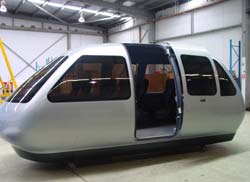Public transport of the future

The Austrans rapid transit system <br>Credit: CSIRO
Public transport systems of the future will feature high-tech vehicles supported, behind the scenes, by revolutionary control and scheduling systems that will make timetables redundant say CSIRO scientists.
CSIRO has developed software that simulates the movement of passengers and vehicles around track-based public transport networks that are designed to carry large numbers of people.
The software, called RTSim (Rapid Transit Simulator), lets researchers study the effects of changing design and operation parameters of this type of public transport system.
“We can study the effect of changing characteristics such as platform length, track alignment and the average speed of the vehicles. We can also simulate passenger flow to understand how the system would respond to different demands,” says CSIRO mathematician Dr Phil Kilby. “This shows us how to maximise passenger throughput to get the most out of the system.”
“Understanding the factors that affect passenger flow is important for basic design of public transport systems. Even something as simple as how tickets are purchased can affect how many passengers a system can carry,” he says.
RTSim demonstrates that public transport can be demand-responsive, with vehicles responding to passenger demand rather than running to timetables. In such a system, passengers would be served not in order of arrival at the station but in a way that optimises each journey, minimising the number of stops and finding the shortest possible route for each traveller in the network.
BASim, based on RTSim, is being used by Bishop Austrans to model potential installations of their Austrans rapid transit system.
Austrans is an ultra light rail automated people mover system based on individual lightweight passenger car size vehicles. The standard vehicle seats nine passengers in air-conditioned comfort. The vehicles can be scheduled like a bus or operate on demand like an elevator.
“BASim has been an essential tool for us to evaluate and model the performance of the Austrans system,” says Managing Director of Bishop Austrans, Laurie Bishop. “We have been able to test different scenarios and layouts to optimise the most efficient and minimum cost infrastructure solutions. BASim has allowed us in Austrans to do research into different system configurations and to validate real world applications.”
Through its intrinsic design Austrans has the following key characteristics:
- Outstanding value for money with low cost of installation and operation compared to other motorised modes of transport that in typical urban applications requires no operating subsidies.
- User friendly with ease of an elevator, and convenience and comfort of a car.
- Environmentally and greenhouse friendly compared with other motorised transport modes.
- Ease of routing and installation flexibility through its small vehicle mass and footprint, tight turning and steep grade climbing abilities.
- Adaptability of its operations and capacity to meet demand and ability to develop and adapt networks over time.
- Safe and reliable through extensive testing and fail-safe design and controls.
CSIRO researchers have also applied the mathematics behind RTSim to simulate a variety of other supply and demand situations, such as scheduling containers for transport by train and truck, and running auto-pickers at warehouses.
The Austrans test track and program was launched today by former Deputy Prime Minister Mr Tim Fischer.
Media Contact
All latest news from the category: Transportation and Logistics
This field deals with all spatial and time-related activities involved in bridging the gap between goods and people, including their restructuring. This begins with the supplier and follows each stage of the operational value chain to product delivery and concludes with product disposal and recycling.
innovations-report provides informative reports and articles on such topics as traffic telematics, toll collection, traffic management systems, route planning, high-speed rail (Transrapid), traffic infrastructures, air safety, transport technologies, transport logistics, production logistics and mobility.
Newest articles

Webb captures top of iconic horsehead nebula in unprecedented detail
NASA’s James Webb Space Telescope has captured the sharpest infrared images to date of a zoomed-in portion of one of the most distinctive objects in our skies, the Horsehead Nebula….

Cost-effective, high-capacity, and cyclable lithium-ion battery cathodes
Charge-recharge cycling of lithium-superrich iron oxide, a cost-effective and high-capacity cathode for new-generation lithium-ion batteries, can be greatly improved by doping with readily available mineral elements. The energy capacity and…

Novel genetic plant regeneration approach
…without the application of phytohormones. Researchers develop a novel plant regeneration approach by modulating the expression of genes that control plant cell differentiation. For ages now, plants have been the…





















